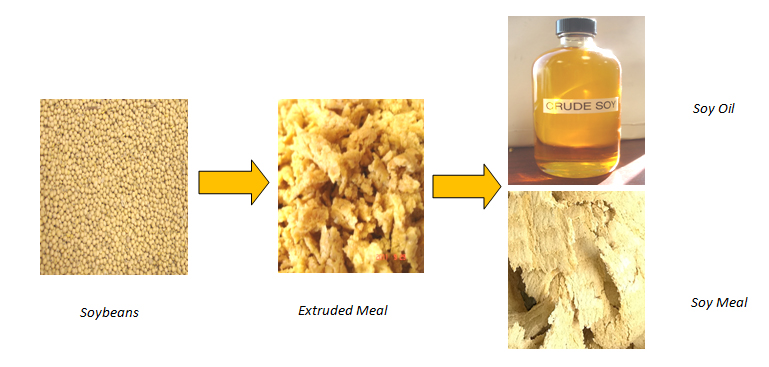|
Mini Crush Plants
What is a Mini Extruder?
Soybeans or other seeds are processed in an extruder to produce extruded or “cooked” meal. The extruder does not typically remove any oil; hence, the extruded meal is called “Full-Fat” meal. The “Full-Fat” meal contains protein, fiber, moisture and oil. Oil can be expelled from the seeds or extruded meal by using a mechanical press as explained later. When oil is removed, the meal becomes more protein and fiber-rich. It still contains some oil; hence, expelled meal is called “Partially defatted” meal.
What is the need for Extrusion?
Oil seeds and kernels are heated for two reasons. First, to reduce or destroy certain “allergens” or “enzymes” which are offensive or undesirable for human and animal consumption. Conventional methods of heating seeds involve steam-cooking or roasting. In addition, such methods require elaborate array of equipment and space. Extruder uses mechanical energy to create heat rather than subject the seeds to direct contact with steam or indirect heat. By avoiding steam or heat, the extruder operation is clean, convenient, and efficient. Depending upon the requirement, an extruder can be employed to rupture oil-cells in oil-seeds and kernels so that the oil can be pressed easily. An extruder can also be used to blend two or more grains, oil-seeds, or other ingredients to cook them into ready-to-eat food preparations.
What do you do with the Meal?
The mechanical pressing can extract anywhere from 50 to 75% oil contained in the seeds or kernels. This implies that the Defatted meal contains un-expelled oil. Both full-fat and (partial) defatted meal are typically fed to the animals, birds, and fish. In some cases, such meal can also be suitable for human consumption. The meal is obviously a great source of protein and the oil contained in the meal is a valuable source of “energy” or “calories”. Both protein and fat are essential nutrients for growth and survival.
How do you Expel Oil?
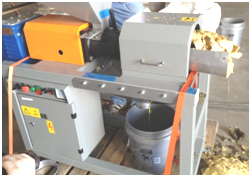 The extruded meal from the Mini-Extruder is fed to the Mini-Expeller to separate the oil from the meal. The oil is squeezed in the Expeller and collected. The other output of the press is “defatted” meal. The press can be adjusted for the amount of pressure and throughput applied on the Extruded meal. The oil content of defatted meal is dependent upon temperature, speed, and pressures applied in the press. Mini-Expellers are available for processing 20 kg/hr, 40 kg/hr, 100 kg/hr, 140 kg/hr, 200 kg/hr, and 500 kg/hr of seeds or extruded meal.
Is the Oil Edible?
How to Refine Oil?
At a minimum, all oils must be decanted or filtered to remove the meal particles and other insoluble solids. In addition, it is advisable to remove gums. Gums can be removed by treating with water. If Free-Fatty Acids are high, they must also be removed to make the oil suitable for human consumption. This can be done by treating with caustic. Oil must be dried after treating with water or caustic. The picture shows a Mini-Degummer. Color and smell are not harmful but they may have to be removed if demanded by consumers. Bleaching to remove the color and Deodorizing to remove smell require more equipment.
Why was the Mini-Crush developed?
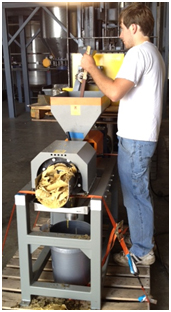 The Mini-Extruder was developed by Triple F., Inc. of Des Moines, Iowa under a grant from National Aeronautics and Space Agency (NASA). NASA’s goal was to employ this technology to prepare high-protein instant foods for astronauts in future space programs. NASA also wanted the technology to benefit humans on earth. Triple F., Inc. granted a license to Technochem to commercialize this technology on earth. The Mini-Extruder has been tested extensively at Triple F., Inc., as well as the Food Science Department at Purdue University, as co-develop
ers of the Mini-Extruder under the NASA grant. Subsequent to acquisition of the licensing agreement, Technochem has continued extensive development and testing and modified the machine.
The Mini-Crush comprising of Mini-Extruder and Mini-Expeller is ideal for creating small start-up businesses at a “Community” or “Village” level in developing countries. Business can transition into larger-scale plants upon achieving success with securing inputs and markets for finished products. The Mini-Crush is also ideal for research-oriented applications. Oil Mills, research organizations, food and feed companies can use the Mini-Extruder to create recipes, test new seeds, and improve process parameters before running them on their commercial scale plants.
What is Mini-Crush’s role in Community Development?
Most countries have a need for “protein” and “cooking oil” as evidenced by the large quantity of imports for both products in those countries. One of the problems in developing agricultural value chains in developing countries is that there is inadequate “Processing” capacity to convert agricultural output into consumer or industrial products. Though countries may have tremendous indigenous potential to grow soybeans and other oil crops such as cottonseed, sunflower, sesame, rapeseed, mustard, and flax (all of which can provide both “protein” and “oil”), there is little interest among farmers to cultivate such crops because of a lack of processing capacity that can convert the crops into protein and oil. Investors do not want to commit large resources to set up commercial scale processing plants just to find out later that there is inadequate or unreliable supply of oil seeds. Given the nascent state of oil-crops cultivation in a number of developing countries, it makes sense to start small and increase the processing capacity as the agricultural capacity grows. Large scale is not very practical because farmers are not set up to produce in large quantities and transportation from farms/villages to towns in not very efficient. We propose the concept of installing “mini” or “community” scale plants based around Mini-Extruder and Mini-Press. The plant can process whole oil-seeds into protein meal and cooking oil. Protein meal can be fed to chickens or ground and added to wheat flour to make breads. It can be blended with other grains to produce snack foods or cooked foods of choice of local population. There is ready market for these products because they are already traded and consumed. Adding protein to the diet of rural people in many developing countries has added social benefit of improving health and cognitive abilities of the future generation.
What is a Mini Crush Plant?
A Mini Crush Plant is a plant to expel oil from a variety of oilseeds and kernels. Some seeds require cold-crushing and some require hot-crushing. Cold-crushing requires just a Mini-Expeller and Hot–Crushing requires a combination of a Mini-Extruder and a Mini-Expeller.
How small is Mini-Crush Business?
One Mini-Extruder can support a production of 1 ton per day of soybeans which is slightly less than the output on 1 acre (0.4 Hectares). In other words, one Mini-Extruder can support production of up to roughly 250 acres (100 hectares) per year. This is an ideal Community-level land area and cultivation to start a community-level business. The investment in the Mini-Extruder is a fraction of the investment in commercial-scale plants, making the Mini-Extruder very attractive. A business centered round the Mini-Extruder can be easily replicated in several communities and provide a basis for widespread national participation in the value-chain. When farmers can see utilization of crops and benefit directly from its derivative products, they will be invested in the projects and make them successful.
Complementary (Optional) Equipment:
A plate-filter to remove meal particles.
Motorized Attachment for Feeding seeds comprising of a 15 kg tank, feeding barrel with screw conveyor, and a 1/16 HP, DC Motor and a Variable Speed Drive
Motorized Bench-Top Seed Cleaner with an Inlet Feed Hopper, TEFC, Motor and Drive, Adjustable Air Bottom Fan, Clean Seed Collection Box, Back Air Catchall for Light Seed / Dust Collection
A degumming skid comprising of a reaction vessel, pump, vacuum pump, and polishing filter to remove hydratable gums from the oil.
A refining skid comprising of vessels for bleaching and deodorizing, vacuum pump, filter press to remove color and smell from the oil.
|
||||
|
||||






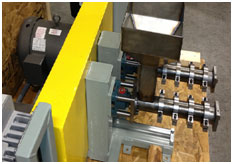 A Mini-extruder is a miniaturized extruder to “cook” oil-seeds or kernels by creating friction with use of mechanical energy. The Mini is a single-screw machine that grinds the seeds which creates friction and cooks the seeds. The Mini-Extruder is driven by a 7.5 HP motor and can process about 40-50 kg of whole soybeans per hour. While the machine can process many types of oil-crops and grains, the capacity depends upon the bulk-density, moisture and oil content, and the desired temperature profile.
A Mini-extruder is a miniaturized extruder to “cook” oil-seeds or kernels by creating friction with use of mechanical energy. The Mini is a single-screw machine that grinds the seeds which creates friction and cooks the seeds. The Mini-Extruder is driven by a 7.5 HP motor and can process about 40-50 kg of whole soybeans per hour. While the machine can process many types of oil-crops and grains, the capacity depends upon the bulk-density, moisture and oil content, and the desired temperature profile.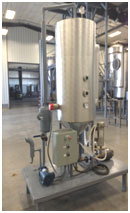 Oil obtained from pressing the seeds is suitable for human consumption. However, there are some impurities that may need to be removed from the oil before it becomes suitable for human consumption. Each type of oil has different levels of impurities and some may contain unique impurities. Typical impurities present in crude oils include Meal Particles, Moisture, Gums, Free-Fatty Acid, Color, Smell, Waxes, and other Impurities. Cold-pressed oil has fewer impurities compared to hot-pressed oil. Gums are emulsifiers and tend to create foaming when the oil comes in contact with water and heat, making it impossible to cook.
Oil obtained from pressing the seeds is suitable for human consumption. However, there are some impurities that may need to be removed from the oil before it becomes suitable for human consumption. Each type of oil has different levels of impurities and some may contain unique impurities. Typical impurities present in crude oils include Meal Particles, Moisture, Gums, Free-Fatty Acid, Color, Smell, Waxes, and other Impurities. Cold-pressed oil has fewer impurities compared to hot-pressed oil. Gums are emulsifiers and tend to create foaming when the oil comes in contact with water and heat, making it impossible to cook. 